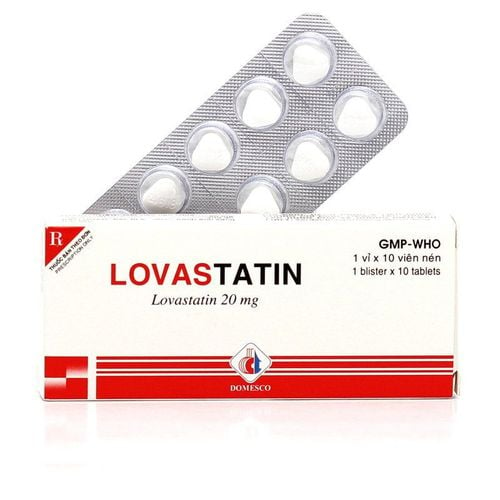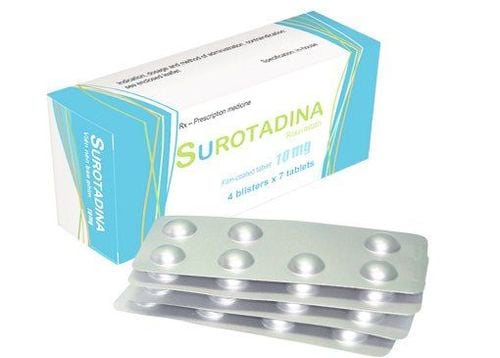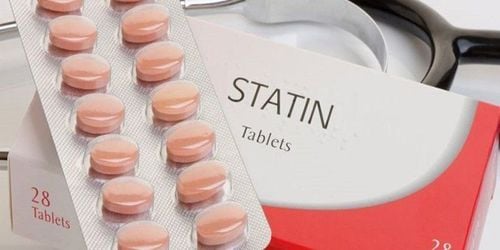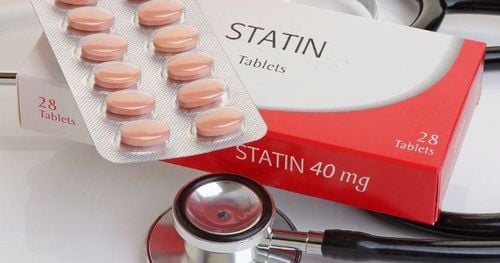This is an automatically translated article.
Lovastatin is a lipid-lowering drug, commonly used in the treatment of hyperlipidemia and the prevention of some cardiovascular diseases. For each treatment purpose, different dosages will be used. Therefore, to ensure that you are using the correct dose, you need to know how much Lovastatin you are taking.
1. Types of drug strength Lovastatin
Lovastatin is a lipid-lowering drug, a statin, that works by reducing the amount of cholesterol made by the liver. Lowering "bad" cholesterol and triglycerides and increasing "good" cholesterol reduces the risk of cardiovascular disease, preventing strokes and heart attacks.
Lovastatin is made in the form of tablets with strengths: 10 mg, 20 mg, 40 mg. Lovastatin is indicated in the following cases:
Dyslipidemia: Primary hypercholesterolemia and mixed dyslipidemia, homozygous familial hypercholesterolemia and hypertriglyceridemia. Primary prevention of cardiovascular events: In patients with hypercholesterolemia without clinically evident coronary heart disease, lovastatin is indicated to reduce the risk of severe acute coronary events such as myocardial infarction, pain, and myocardial infarction. unstable angina, stroke. Secondary prevention of cardiovascular events: In patients with hypercholesterolemia who have clinical manifestations of coronary heart disease, lovastatin is indicated to reduce the risk of death, reduce recurrence of myocardial infarction, stroke. or transient ischemic attack , congestive heart failure , and reduce the risk of needing a coronary revascularization procedure . Prevention of cardiovascular events in patients with diabetes. Reduces progression of coronary atherosclerosis in hypercholesterolemic patients with clinical manifestations of coronary artery disease including previous myocardial infarction, helps to slow the progression of coronary atherosclerosis. Lovastatin is contraindicated in the following cases:
People with hypersensitivity to any component of the drug. Active liver disease or unexplained persistent elevations in blood transaminases. Pregnant or lactating women.
2. How to use Lovastatin
You need to follow a low cholesterol diet before taking Lovastatin and must continue to maintain this diet for the duration of treatment.
Lovastatin is used by mouth. Because cholesterol synthesis in the liver takes place mainly at night, patients need to take the drug at night to increase the effectiveness of the drug. Besides, you should take Lovastatin with meals for maximum absorption.
The doctor will adjust the dose of Lovastatin to the needs and response of each patient by increasing the dose at least 4 weeks apart, until the desired level of LDL cholesterol is reached or when the maximum dose is reached. .
Dosage of Lovastatin should be according to the doctor's prescription, the reference dose for the following cases:
Lovastatin dose for adults:
Usual dose: Use a starting dose of 20mg, once daily, take medicine in the evening. If necessary, the dose will be adjusted every 4 weeks. Maintenance dose is from 20 - 80mg per day, taken 1-2 times, with meals. For patients on immunosuppressive therapy, lovastatin should be initiated at a dose of 10 mg daily and not to exceed 20 mg/day. The maximum dose of Lovastatin for adults is 80mg per day. Pediatric dose of Lovastatin:
Children 10–17 years of age who need to reduce their LDL-cholesterol index ≥ 20%: Use a starting dose of 20mg x 1 time / day. Children 10–17 years of age requiring a small reduction in LDL-cholesterol: Consider an initial dose of 10 mg once daily. Adjust the pediatric dose of Lovastatin at intervals of ≥ 4 weeks until the desired effect is achieved. The recommended dose range for children 10-17 years of age is 10–40 mg per day. Lovastatin dosage for other subjects:
Patients with severe renal impairment (ClCr < 30mL/min): Care should be taken when increasing the dose of Lovastatin > 20mg daily if deemed necessary. The usual initial dose of Lovastatin in patients ≥ 65 years of age is 20 mg once daily. Use higher doses of Lovastatin only after carefully weighing the risks and benefits.
3. Lovastatin side effects
During the use of Lovastatin, you may experience side effects of the drug. Common side effects of Lovastatin include:
Diarrhea Constipation Bloating Abdominal pain and nausea. Headache Dizziness Blurred vision Insomnia Weakness Muscle pain, joint pain. Liver function test results increased to 3 times the upper limit of normal. However, the majority of patients are asymptomatic and usually recover on discontinuation of the drug. Uncommon side effects of Lovastatin include:
Myopathy Skin rash Rhinitis Sinusitis Sore throat Rare side effects of Lovastatin include:
Cognitive impairment such as memory loss, confusion. Myositis, rhabdomyolysis, leading to acute renal failure secondary to myoglobinuria. Increased HbA1c and increased fasting blood glucose. May increase your risk of developing diabetes. Lovastatin is a lipid-lowering drug, commonly used in the treatment of hyperlipidemia and the prevention of some cardiovascular diseases. Recognizing the types of Lovastatin drug levels will help patients use the right dose, avoid causing side effects.
Follow Vinmec International General Hospital website to get more health, nutrition and beauty information to protect the health of yourself and your loved ones in your family.
Please dial HOTLINE for more information or register for an appointment HERE. Download MyVinmec app to make appointments faster and to manage your bookings easily.













